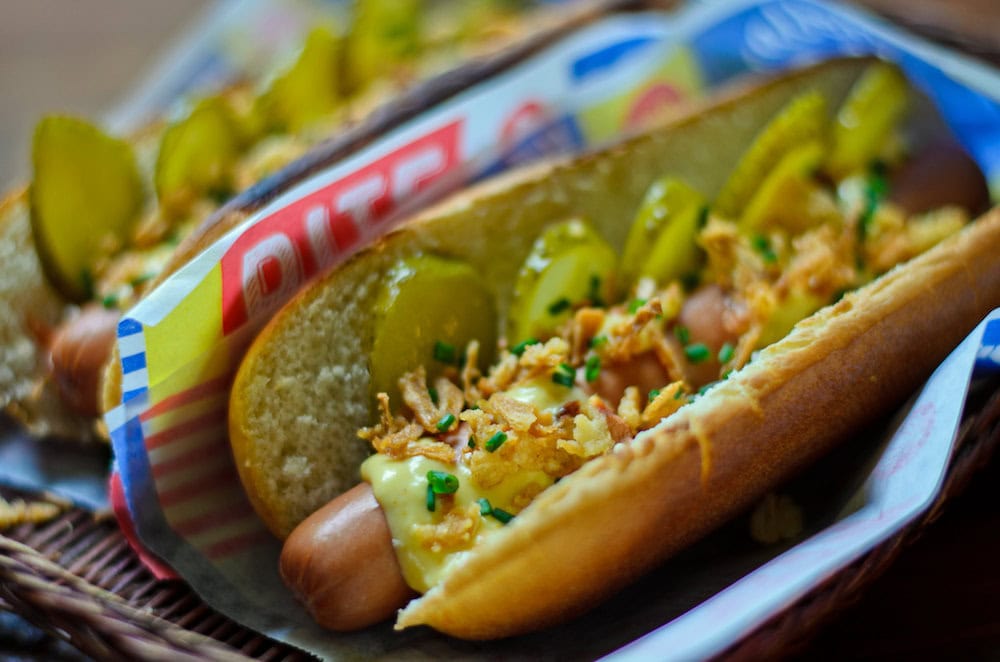
[Image above] Hot dogs—a delicious source of biomaterials inspiration. Credit: Stefan Muth; Flickr (CC BY-SA 2.0)
Inspiration can come from unexpected sources.
Take, for example, the intermittent function of an automobile’s windshield wipers—I never would have guessed that was inspired by how we blink our eyes.
I also wouldn’t expect food to serve as inspiration for a biomaterials solution to repair bone. Yet a recent meal was apparently inspiring for a group of researchers in China and Germany.
The researchers—at Shanghai Institute of Ceramics Chinese Academy of Sciences (Shanghai, China), University of Chinese Academy of Sciences (Beijing, China), and Technische Universität Dresden (Dresden, Germany)—developed a unique 3D printing process to fabricate bioceramic structures, reminiscent of hot dogs, that frankly could be a fantastic solution to repair large bone defects.
The two-step method combines a 3D printing process called direct ink writing, in which a liquid ink is extruded in additive layers, with bidirectional freezing. First, hollow bioceramic tubes made out of akermanite (Ca2Mg[Si2O7]) are printed to form “buns.” Then, these tubes are placed in a bioceramic slurry and bidirectionally frozen to cause ice to form in sheets within the slurry, squishing the slurry in the tubes between pockets of ice.
Using sublimation to remove the ice leaves behind a porous bioceramic structure of “hot dog” rods within the hollow buns. Sintering further causes the microporous hot dog centers to shrink away from the hollow buns, yet remained attached in some areas, resulting in a stable hierarchical structure.

Fabrication and morphology of hot dog‐like scaffolds. a) Preparation combines 3D printing and bidirectional freezing to fabricate 3D-printed scaffolds containing rods with aligned lamellar microstructure. b–e) 3D micro‐CT images and f,g) 2D micro‐CT images of scaffolds showing their structure, which is hollow tube macropores embedded with bioceramic rods. Credit: Li et al., Advanced Science (CC BY 4.0)
[To be honest, I’d call it more of a corn dog than a hot dog—but you get the idea.]
The team tinkered with the formulation, showing that varying the concentration of the bioceramic slurry changes the structure of the hot dogs, with a higher ratio of bioceramic in the slurry increasing the diameter of the rods but reducing their porosity.
The researchers also successfully fabricated similar structures with various combinations of materials, “suggesting the universality of the strategy,” they write in an open-access paper describing the work.

Hot dog‐like scaffolds are composed of hollow bioceramic tubes embedded with bioceramic rods possessing uniformly aligned lamellar micropores. Panels show different structures of hot dog‐like scaffolds obtained by changing the ratio of AKT in the freezing casting slurry from 20% to 50% (HD‐20AKT, HD‐30AKT, HD‐40AKT, HD‐50AKT). Traditional 3D printed‐solid strut AKT scaffolds and 3D printed‐hollow tube scaffolds are named S‐AKT and H‐AKT. Optical images (first line) and SEM images show lamellar structure. Credit: Li et al., Advanced Science (CC BY 4.0)
In addition to characterizing their 3D-printed hot dogs, the researchers also demonstrated the dogs are biocompatible. In vitro experiments with cultured cells showed bone stem cells successfully attached to the bioceramic scaffolds. And in vivo experiments, in which bioceramic scaffolds were implanted into large defects in rabbit leg bones, spurred new bone formation after eight weeks, indicating their potential bone-repairing bioactivity.
In addition to allowing cells to interact with the materials, the structures’ porosity also means the bioceramics could be used to deliver drugs or proteins, for example, by loading these payloads into the open pores. And the ability to control the bioceramic’s microstructure means the porosity could be custom-tailored to efficiently deliver a specific payload.
Further work will be needed to determine the functionality, applicability, and safety of such scaffolds for human bones. But frankly, this is an inspiring start.
The open-access paper, published in Advanced Science, is “3D printing of hot dog‐like biomaterials with hierarchical architecture and distinct bioactivity” (DOI: 10.1002/advs.201901146).
Author
April Gocha
CTT Categories
- Biomaterials & Medical
- Material Innovations


